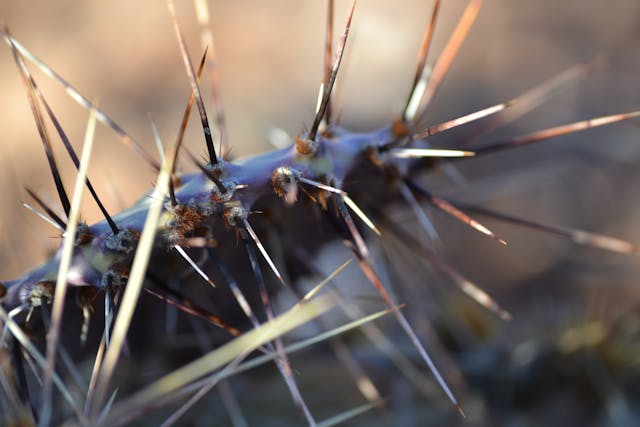
Why do some plants have thorns? Plants generally have thorns to deter herbivores and insects from eating them. Plants usually have parts that they want to be eaten (the fruit, for example) and parts that they don’t want to be eaten (the stem and leaves).
Plants have different methods of scattering their seeds. Some do it through the wind, some do it through explosive discharge, and many do it through animal distribution. To do this, they have a seed with a very strong protective covering inside a brightly colored and delicious fruit. Animals eat the fruit and digest it, but the hard coating of the seed allows it to sail all the way through the animal’s digestive system without any trouble. It comes out the other end and germinates. This is ideal. Plants also rely on a lot of insects for cross-pollination. They have bright, highly scented flowers to guide the insects into the right part of the plant.
However, there are a lot of animals and insects that prefer to eat the green and leafy parts of the plant rather than the fruit, such as deer, cattle, and caterpillars. The herbivores have evolved digestive systems that allow them to get a lot of energy out of the cellulose part of the plant. Caterpillars have a host of bacteria inside them that can break down the cellulose as well. Plants can produce fruit year after year, but losing their leaves or their stems is a big problem. Without the leaves, they won’t be able to photosynthesize, and without the stems, they won’t be able to support themselves. To prevent this, a lot of plants have evolved some system of defense, and the most common method is thorns, spines, and prickles.
Thorns, spines, and prickles may all seem the same, but they actually have different origins. Thorns come from the stem of the plant, and they are modified shoots. They are not leaves; they are more like modified branches. They are made of stem tissue and are very stiff. They can be a variety of lengths, some very long. Spines may look like thorns, but they are modified leaves. They grow out of the same place that leaves grow from, but they form thin needle shaped spikes. They can also be a variety of lengths. And then there are prickles. Prickles grow from the outer covering of the stem, and they tend to be shorter. The thorns on roses are actually prickles not thorns. Thorns and spines grow from the same places that branches and leaves grown from, so they are predictable. Prickles appear to grow in random places.
Cacti have spines, but, interestingly, they use them for more than just protection from herbivores. The spines of the cactus can give some shade to the trunk, and they can direct water downwards. Deserts are cold at night and often a dew will form. The spines give the dew a place to condense, and then their shape directs the water down towards the roots. The spines are also a better alternative than leaves because they would lose too much water through the large surface area of leaves.
So, the purpose of thorns, spines, and prickles is to stop animals from eating the plants. With the majority of animals, they work by either making it too painful to get close to the plant, too painful to climb the plant, or too painful to eat the plant. That doesn’t always work, and a lot of herbivores have evolved to have very strong tongues and teeth that can cope with thorns. They have molars that constantly regrow so that they can grind their food. This is to break down as much of the cellulose as possible, but it also works on thorns. Although when it comes to eating thorny food, camels may have all other herbivores beaten. Camels have evolved to be able to eat cacti, some of the spikiest food there is. They have tough lips and a hard palate at the top of their mouths for protection. They also have grooves on the roof of their mouth called papillae. When they grind the cactus, these papillae orient the spines so that they go down the camel’s throat in the same direction and don’t get stuck. Then they have strong bacteria in their stomachs to break everything down.
It does seem that herbivores are the biggest reason that plants have thorns, but research has shown that thorns, spines, and prickles are very effective at preventing caterpillars from climbing up a plants stem to get to the leaves. A swarm of caterpillars can do as much damage to a plant, or sometimes even more, than a herbivore might. You would think that the caterpillars would be able to climb up and around the thorns, but researchers found that the more thorns a plant has, the more likely caterpillars are to fall off and have to start climbing all over again. As herbivores have become more able to eat thorns, plants have developed toxins. These toxins don’t work on caterpillars, but the thorns do. And this is what I learned today.
Sources
https://en.wikipedia.org/wiki/Thorns,_spines,_and_prickles
https://www.nationalgeographic.com/animals/article/camels-cactus-mouth-papillae-animals
https://news.yale.edu/2020/06/18/yale-scientists-solve-thorny-problem
https://www.huntington.org/verso/spines-thorns-and-prickles
https://myplantin.com/blog/plants-with-thorns
https://www.vermontpublic.org/programs/2021-01-29/why-are-cactuses-spiky
Photo by Hunter Harmon: https://www.pexels.com/photo/macro-photography-of-spiky-plant-814058/
